Firewood Types and their Heat Output 2025
- September 18, 2023
- 1 comment
Every winter, as the chill in the air deepens and the nights grow longer, fireplaces and wood-burning stoves across the world spring to life, casting their warm, flickering glow on surrounding walls. But have you ever stopped to consider why some fires roar with a ferocious heat while others maintain a gentle, steady warmth? Or why do certain woods emit a delightful aroma, turning a simple fire into a sensory experience? The answers to these questions lie in the type of wood you choose to burn.
This guide will lead you through the labyrinth of firewood choices, ensuring that the next time you light a fire, it’s not just the warmth you feel but a deeper connection to the world outside.
Firewood Wood Types List:
- Oak Firewood
- Hickory Firewood
- Maple Firewood
- Birch Firewood
- Pine Firewood
- Spruce Firewood
- Cherry Firewood
Now, let’s delve into the heart of the matter and explore the various firewood types, each with its unique characteristics and heat outputs.
The Science of BTUs
Before diving into the specifics of each wood type, let’s discuss BTUs or British Thermal Units. A BTU is a measure of heat energy, specifically the amount required to raise the temperature of one pound of water by one degree Fahrenheit. When we speak about the heat output of firewood, we’re referring to its BTU content. The higher the BTU, the more heat the wood will produce when burned.
Top Firewood Types and Their Heat Outputs
1. Oak Firewood
Oak, a hardwood, is often a top pick for firewood across various regions, and for good reason. The characteristics that make oak firewood so desirable include:
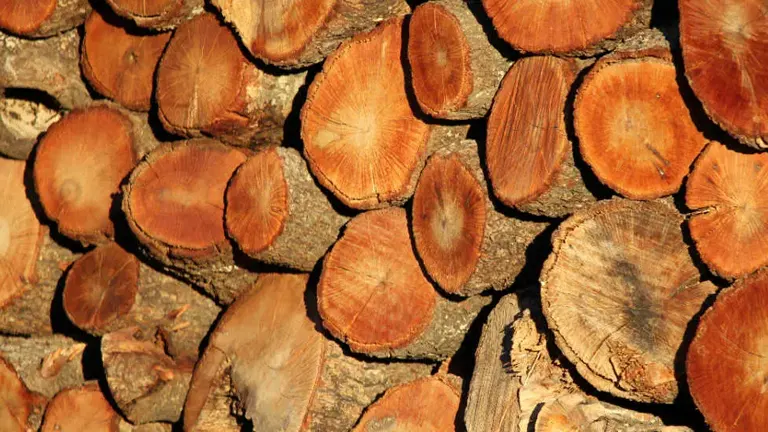
- High Heat Output: One of the primary attributes of any good firewood is its ability to produce a significant amount of heat. Oak certainly lives up to this expectation. When compared to other types of wood, oak provides an impressive amount of heat, which ensures a warm and cozy environment for those relying on it as a heat source.
- Slow Burning: Not all woods burn at the same rate. Oak has the advantage of burning slowly. This means that once lit, an oak log will last longer than many other types of wood, making it efficient and reducing the frequency with which you need to add logs to the fire. This slow burn is particularly beneficial for long, chilly nights when one would want a continuous heat source without the need to keep refueling the fire constantly.
- BTU (British Thermal Units): BTUs are a measure of the heat content of fuels. When we talk about firewood, the BTU content indicates how much heat you can expect the wood to produce. A cord of oak firewood typically produces between 24 to 29 million BTUs. This is a high energy content and further emphasizes why oak is a preferred choice for heating. For comparison, other woods might have significantly lower BTU values, making oak a superior choice in terms of energy efficiency.
- Versatility: While the above attributes specifically relate to oak’s use as firewood, it’s also worth noting that oak is versatile. It can be used in indoor fireplaces, wood-burning stoves, and outdoor fire pits or campfires.
- Aroma: Many people appreciate the pleasant and distinctive smell that oak wood gives off when burned. This aromatic quality can enhance the ambiance of a fireside setting.
- Less Creosote Buildup: When compared to some softer woods, oak tends to produce less creosote, a sticky byproduct of wood burning that can accumulate in chimneys. Reduced creosote buildup means a cleaner burn and less maintenance for chimneys and flues.
2. Hickory Firewood
Hickory, renowned for its top-tier burning qualities, is often favored among firewood enthusiasts.
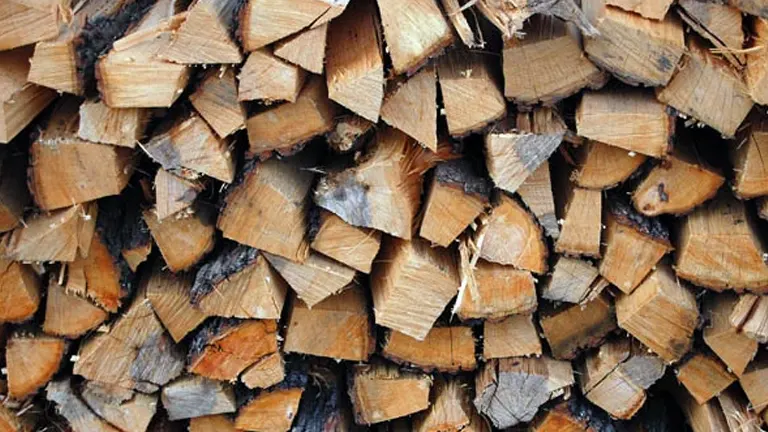
- King of Firewood: The title of “king of firewood” is not given lightly. Hickory has earned this commendation because of its exceptional heating and burning properties. When people think of the best wood to burn, hickory is frequently at the top of the list.
- Hot Burn: Hickory is known for its high heat output. When you burn hickory, you can expect it to release a significant amount of heat, making it perfect for colder environments or for situations where maximum warmth is desired.
- Long Burning Duration: Apart from the intensity of the heat it produces, hickory also impresses with its longevity in the fire. It burns for an extended period, meaning that you won’t have to reload your fireplace or stove as frequently, granting convenience and consistent warmth.
- Aroma: Firewood isn’t just about heat; the aroma it produces can greatly enhance the overall experience. Hickory, when burned, emits a delightful and unique scent, which many people find comforting and reminiscent of cozy, woodsy atmospheres.
- BTU (British Thermal Units): BTU content gauges the energy value of wood, reflecting its heating potential. Hickory stands out with an average of 25 to 30 million BTUs per cord. This high BTU value further cements Hickory’s position as a prime choice for those seeking optimal warmth from their wood.
- Versatility: While the properties mentioned mainly focus on its use as firewood, hickory is also versatile in other applications. Besides heating, hickory wood is prized in culinary circles, especially for smoking meats, due to the rich flavor it imparts.
- Low Creosote Production: Like oak, hickory also tends to produce less creosote compared to softer woods. This leads to cleaner burns and reduces the risk of chimney fires and the need for frequent maintenance.
3. Maple Firewood
Maple, a staple in many North American forests, is also a popular choice when it comes to firewood.
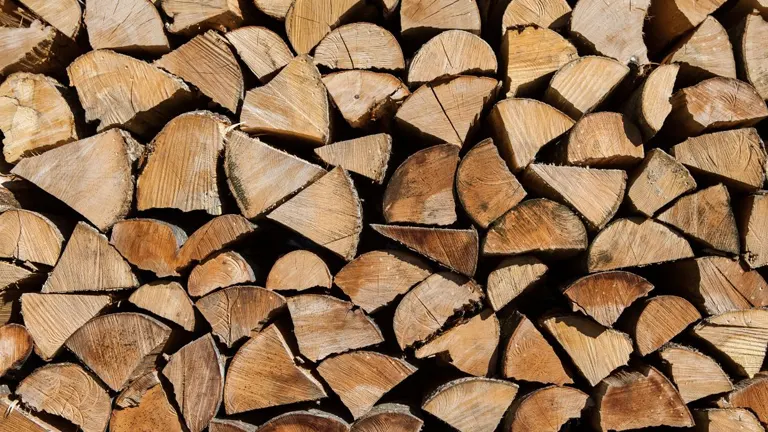
- Hardwood Classification: As a hardwood, maple is denser than many softwoods. This density is responsible for many of its desirable burning properties, such as a longer burn time and a steady release of heat.
- Consistent Burn: One of the highlights of burning maple is its consistency. Unlike some woods that may pop, crackle excessively, or burn unevenly, maple typically offers a more predictable and steady burn. This means fewer surprises and a more manageable fire, whether you’re using it in a fireplace, stove, or an outdoor fire pit.
- Good Heat Output: While perhaps not as intense as some other hardwoods like oak or hickory, maple still provides a commendable heat output. It’s warm enough to be relied upon during colder seasons, ensuring comfort and warmth.
- BTU (British Thermal Units): The BTU rating of a wood indicates its heat content or energy value. Maple firewood boasts an average BTU range of 18 to 25 million BTUs per cord. This places it in a respectable position among hardwoods and ensures that it delivers a substantial amount of heat when burned.
- Versatility: Maple’s consistent burn and decent heat output make it suitable for a variety of settings, from home heating to campfires. Its versatility also extends to maple being used in smoking and grilling, lending a subtle sweetness to meats.
- Availability: In regions where maple trees are abundant, such as the northeastern parts of the United States and Canada, maple firewood is readily available. This makes it an affordable and accessible choice for many homeowners.
- Low to Moderate Creosote Production: Maple, when burned properly, tends to produce a moderate amount of creosote. While not as low as oak or hickory, it’s still relatively cleaner compared to many softwoods. This means there’s a reduced risk of excessive creosote buildup in chimneys, which can lead to chimney fires.
4. Birch Firewood
Birch, often recognized by its distinctive white bark, is a favorite for many when it comes to firewood.

- Burn Rate: Birch tends to burn at a quicker rate than denser hardwoods like oak or hickory. This might mean that you’ll need to reload your fireplace or wood stove more frequently when using birch. However, this faster burn isn’t necessarily a downside; it can be perfect for shorter, warmer fires or for mixing with slower-burning woods.
- Bright Flame: One of the aesthetic pleasures of burning birch is the bright and lively flame it produces. For those who enjoy the visual aspect of a fire, birch can be a fantastic choice. Its vibrant flame can add ambiance to a room or outdoor setting.
- Decent Heat Output: While birch might not offer the intense heat of some other hardwoods, it still delivers a respectable heat output. It’s warm enough for most applications, especially in settings where immediate warmth is desired.
- BTU (British Thermal Units): A measure of the heat content of wood, birch boasts an average BTU range of 20 to 24 million BTUs per cord. This places it in a moderate range among firewood, ensuring that it can provide satisfactory warmth when needed.
- Pleasant Aroma: Birch is known for having a pleasant, slightly sweet aroma when burned. This can enhance the overall fireside experience, making your space feel cozier and more inviting.
- Bark Characteristics: The bark of birch trees, especially paper birch, can be used as a natural fire starter due to its oil content. This feature can be beneficial when starting fires, as small pieces of bark can be used to ignite larger logs.
- Creosote Production: Birch tends to produce a moderate amount of creosote. It’s essential to ensure proper ventilation and burn it hot to reduce creosote buildup in chimneys and flues. Regular chimney maintenance and cleaning are recommended when using woods like birch.
- Versatility: Due to its faster burn and bright flame, birch can be a great choice for both indoor and outdoor fires, especially when a quick, warm fire is desired.
5. Pine Firewood
Pine, a prevalent tree found in many regions, is often used as firewood, especially in areas where hardwoods might be less abundant.
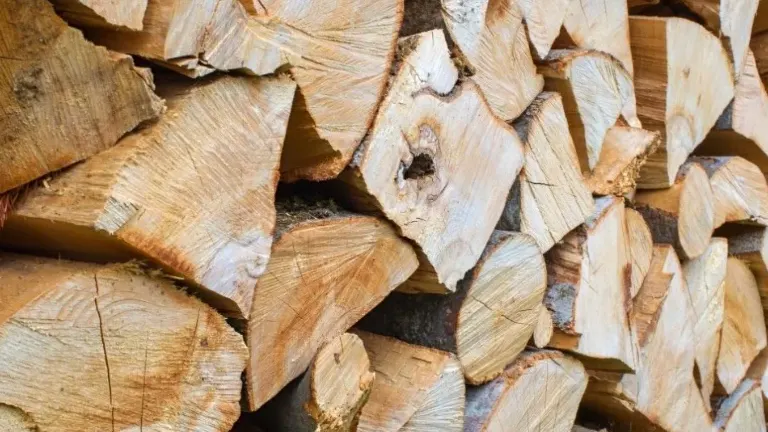
- Softwood Classification: Unlike hardwoods like oak, hickory, or maple, pine is a softwood. Softwoods are generally less dense than hardwoods. This inherent difference impacts how pine burns when compared to its hardwood counterparts.
- Quick Ignition: One of the most prominent features of pine is its ability to ignite quickly. This trait makes it particularly useful when starting a fire, as it can help establish flames faster than denser woods.
- Moderate Heat Output: While pine won’t produce as much heat as some of the top-tier hardwoods, it still offers a respectable heat output. Its warmth is sufficient for milder winter days or during transitional seasons like spring and fall.
- BTU (British Thermal Units): Reflecting its energy value, pine has an average BTU range of 15 to 20 million BTUs per cord. This is on the lower end when compared to many hardwoods, but it still can provide a fair amount of heat, especially for its quick burn rate.
- Ideal for Kindling: Given its quick ignition properties, pine (especially smaller pieces or shavings) can be an excellent choice for kindling. It helps to get a fire going before adding more dense woods that burn longer.
- Resinous Nature: Pine contains a significant amount of sap or resin. This can lead to pronounced crackling and popping when burned, which some people enjoy for the ambiance it creates. However, this same resinous nature can lead to increased creosote buildup in chimneys.
- Pleasant Aroma: Pine is known for its distinct, refreshing aroma when burned. This scent is often associated with the holidays or woodland environments, adding to the overall ambiance of the fire.
- Creosote Production: Due to its sap content and being a softwood, pine can produce more creosote than many hardwoods. It’s essential to burn pine hot and ensure regular chimney cleanings to reduce the risk of excessive creosote accumulation and potential chimney fires.
- Affordability and Availability: In regions where pine trees are plentiful, pine firewood is often more affordable and widely available compared to hardwoods.
6. Spruce Firewood
Spruce, commonly associated with northern and alpine regions, is often utilized as firewood in areas where it’s abundant.
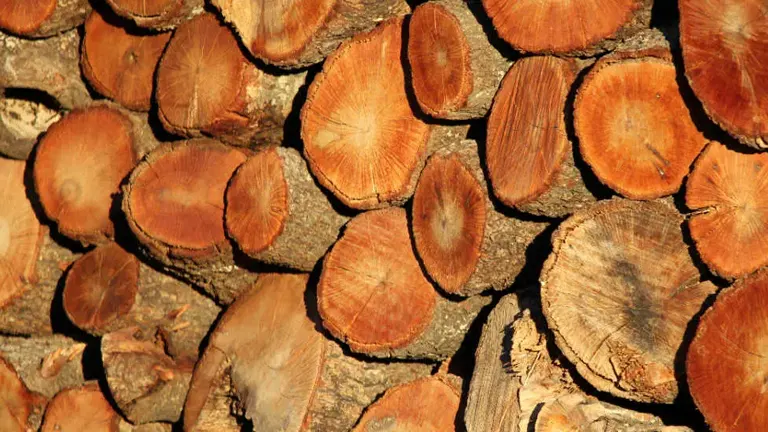
- Softwood Classification: Spruce, like pine, falls under the category of softwoods. Generally, softwoods are less dense than hardwoods, which affects their burning characteristics, particularly the speed at which they burn.
- Fast Burn Rate: Due to its nature as a softwood, spruce tends to burn relatively quickly. While this might mean that it doesn’t last as long as denser hardwoods in a fire, it also means it can provide quick warmth and is easily ignited.
- Moderate Heat Output: While spruce doesn’t boast the high heat levels of top hardwoods, it offers a decent, moderate heat output. This makes it suitable for situations where intense, long-lasting heat isn’t the primary goal.
- BTU (British Thermal Units): BTU is a measure of the heat content or energy value of wood. Spruce’s BTU range is between 15 to 18 million BTUs per cord. This is on the moderate to lower end of the scale, reflecting its quick burn rate and moderate heat output.
- Perfect for Transitional Seasons: Given its characteristics, spruce is a solid choice for transitional seasons like spring and fall. During these times, the need for intense heat is reduced, and the quick warmth provided by spruce can be ideal.
- Less Creosote than Pine: While all softwoods tend to produce more creosote than hardwoods, spruce generally produces less creosote than resinous woods like pine. However, it’s still important to burn it hot and ensure regular chimney maintenance to minimize creosote buildup.
- Availability in Northern Regions: In areas where spruce trees are common, such as the northern parts of North America and Europe, spruce firewood is often a readily available and affordable choice.
- Lighter Aroma: Spruce has a lighter, somewhat refreshing scent when burned. For some, this aroma is reminiscent of alpine regions and can enhance the fireside experience.
- Resin Pockets: Some spruce varieties may contain pockets of resin which can cause a crackling effect when burned. This can be enjoyable for the ambiance, but it’s wise to be cautious of sparks.
7. Cherry Firewood
Cherry, often celebrated for its beautiful wood grain in furniture and woodworking, also holds a special place in the world of firewood.
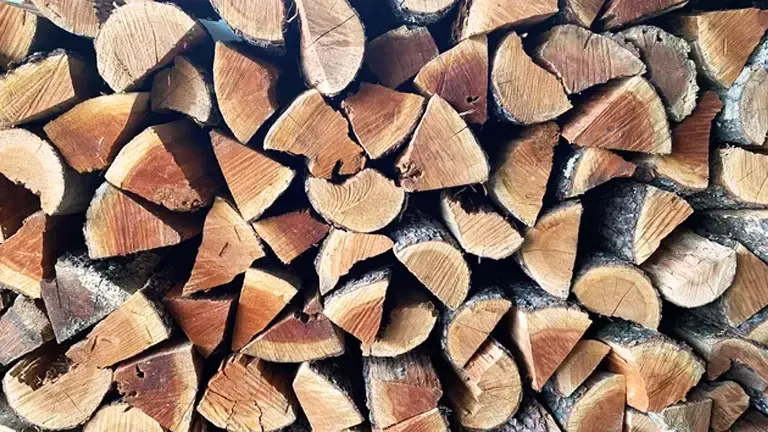
- Moderate Heat Production: Cherry wood provides a moderate heat output. While it doesn’t rival the intense heat generated by hardwood giants like hickory or oak, it can still offer sufficient warmth for many households, especially in milder climates or during transitional seasons.
- BTU (British Thermal Units): The heat content or energy value of a wood is measured in BTUs. Cherry wood comes in with an average of 20 to 21 million BTUs per cord. This is a respectable figure, placing it in the mid-range among firewood in terms of heat output.
- Delightful Aroma: One of the standout features of burning cherry wood is its distinct, pleasing aroma. This sweet, fragrant scent is often considered one of the best among firewood. The aroma can greatly enhance the ambiance of a room, making fireside moments even more memorable.
- Clean Burn: When seasoned properly, cherry wood tends to burn cleanly with less smoke compared to some other woods. This means fewer particulates are released into the air, making for a more pleasant fireplace or wood stove experience.
- Beautiful Flame: Cherry produces a vibrant, mesmerizing flame, adding to the aesthetic appeal of a burning fire. This characteristic, combined with its signature aroma, creates a unique sensory experience.
- Seasoning Time: It’s essential to ensure cherry wood is adequately seasoned (dried) before use. Properly seasoned cherry burns efficiently, whereas unseasoned or “green” cherry can produce excessive smoke and potentially more creosote.
- Low Creosote Production: Compared to some other woods, cherry typically produces less creosote when burned correctly. This is beneficial as creosote buildup in chimneys can lead to potential fire hazards.
- Splitting Ease: Cherry is relatively easier to split compared to some denser hardwoods, making the wood preparation process a bit more user-friendly.
Factors to Consider When Choosing Firewood
- Moisture Content: For the best burn, firewood should be seasoned, meaning it’s been dried for at least six months. Freshly cut, or “green”, wood contains a lot of moisture, making it harder to ignite and producing more creosote, which can build up in chimneys.
- Hardwood vs. Softwood: Hardwoods, derived from deciduous trees, usually provide a higher heat output and burn longer than softwoods. Softwoods come from coniferous trees and ignite more easily, making them great for kindling.
- Availability: Some types of firewood might not be readily available in all regions. It’s essential to know which woods are abundant in your area.
- Cost: Hardwoods usually cost more than softwoods due to their higher BTU content and longer burning time.
Safety First with Firewood
No matter the charm and warmth a fireplace or wood-burning stove brings to a home, it’s imperative to ensure safety at all times. Here’s an expanded look into the essential safety measures when dealing with firewood:
Well-Maintained Chimney
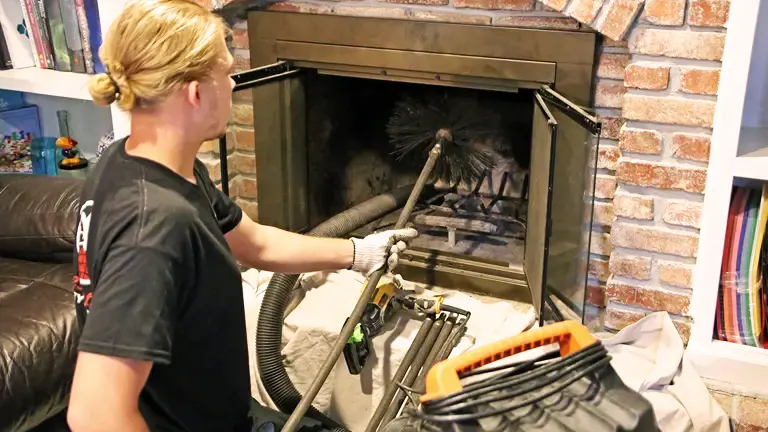
- Regular Inspections: It’s crucial to have your chimney inspected annually by a professional. Over time, creosote, a flammable byproduct of wood combustion, can accumulate inside the chimney. This buildup can pose a fire hazard.
- Chimney Sweeping: Depending on how frequently you use your fireplace or stove, and the type of wood you burn, you might need to have your chimney swept more than once a year to prevent excessive creosote buildup.
Protective Screen
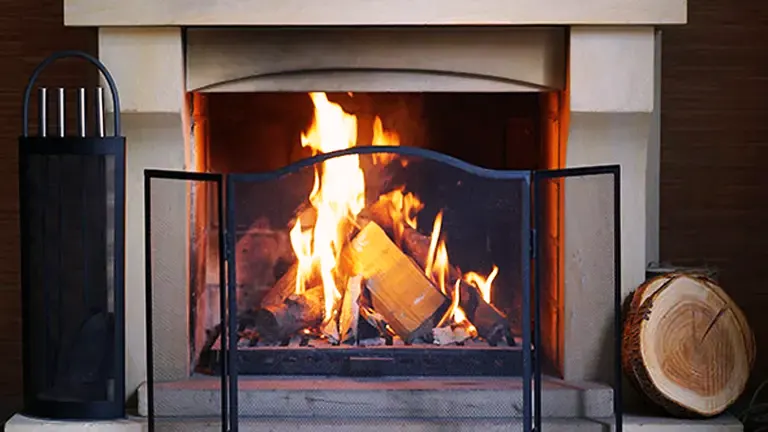
- Preventing Sparks and Embers: A protective screen or fireplace door helps contain sparks and embers, preventing them from escaping into the room where they could ignite flammable materials.
- Guard Against Curiosity: If there are children or pets in the home, a screen can serve as a barrier, deterring them from getting too close to the flames.
Never Leave a Fire Unattended

- Unpredictability of Fires: Even if a fire seems calm and under control, it can quickly become unpredictable. A sudden draft or a shift in the wood can cause a flare-up or a sudden release of sparks.
- Extinguishing the Fire: If you’re leaving the room or going to bed, ensure the fire is completely out. Use fireplace tools to spread out the embers and ashes and sprinkle them with a little water to make sure there’s no chance of them reigniting.
Additional Safety Measures
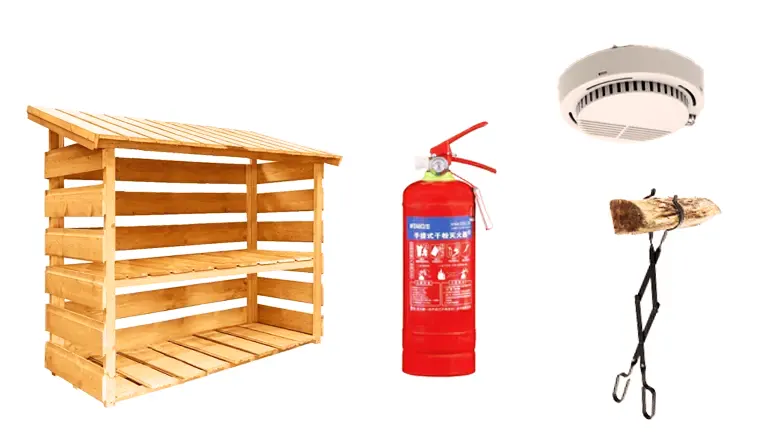
- Smoke Alarms and Carbon Monoxide Detectors: Install and regularly test smoke alarms and carbon monoxide detectors in your home. This provides an early warning system in case of issues.
- Safe Wood Storage: Store firewood away from the home and elevated from the ground. This reduces the chance of pests making a home in the woodpile and prevents wood from absorbing moisture.
- Use the Right Tools: Always use appropriate fireplace tools, such as tongs or poker, when adjusting or moving logs. This ensures you can safely handle the wood without getting too close to the flames.
- Fire Extinguisher: Keep a fire extinguisher nearby and ensure all members of the household know how to use it.
Conclusion
Choosing the right firewood can enhance your fireplace experience, ensuring you get the desired warmth and ambiance. Armed with knowledge about different firewood types and their heat outputs, you’re now prepared to make an informed decision for those chilly nights ahead. Happy burning!
FAQs
- How do various wood types differ in terms of BTU output?
BTU (British Thermal Unit) measures the heat content of firewood. Hardwoods like oak, hickory, and maple usually have high BTUs, often ranging from 18-30 million BTUs/cord, while softwoods like pine and spruce typically offer 15-20 million BTUs/cord. - What makes hardwood generally better for heating than softwood?
Hardwoods are denser than softwoods, which means they usually provide a higher heat output and burn longer. - Why is birch often considered a choice for ambiance despite its moderate BTU?
Birch produces a bright and lively flame and has a distinct bark that’s visually appealing. It also emits a pleasant aroma when burned. - Are there any woods that should be avoided due to potential health risks?
It’s essential to avoid burning woods like poison ivy, poison oak, and poison sumac as they can release toxic substances when burned. - How does the moisture content of firewood affect its heat output?
Dry, seasoned wood has a higher heat output compared to green or freshly-cut wood. Moisture in wood reduces its efficiency, causing it to produce more smoke and less heat. - How do fruitwoods like cherry and apple compare in terms of heat output?
Fruitwoods generally have moderate heat outputs. Cherry wood often offers around 20-21 million BTUs/cord, while apple wood can range between 22-27 million BTUs/cord. Both are prized for their aromatic burn. - Is kiln-dried firewood more efficient than naturally seasoned wood?
Kiln-dried firewood is dried in a controlled environment, reducing its moisture content more rapidly than natural seasoning. This ensures optimal heat output and a cleaner burn. - How does the region or climate impact the types of firewood available?
Different tree species thrive in different climates and soils. Therefore, the firewood types available often depend on the local forests and tree species native to a particular region. - Why is oak often recommended for wood-burning stoves?
Oak is a dense hardwood that provides a high heat output and burns slowly. Its consistent and long burn makes it ideal for wood-burning stoves. - Can the aroma of the firewood enhance the fireplace experience?
Absolutely! Woods like cherry, apple, and hickory are known not just for their heat output but also for the pleasant aroma they release when burned, elevating the ambiance of any setting.
We’d love to hear from you! Share your personal experiences and insights about different Firewood Types and their Heat Output in 2025 in the comments section below. Your knowledge could help fellow wood burners choose the best firewood for their needs!

David Murray
Forestry AuthorI'm David Murry, a forestry equipment specialist with a focus on chainsaw operation. With over 13 years of experience, I've honed my skills in operating and maintaining a wide range of machinery, from chainsaws to log splitters. My passion for the outdoors and commitment to sustainable forestry drive my work, which emphasizes safety, efficiency, and staying updated with industry advancements. Additionally, I'm dedicated to sharing my expertise and promoting environmental awareness within the forestry community.













A Great article - very informative, especially the detailed descriptions of the burn characteristics of the various types of logs. I would welcome an extended list to include other popular wood types, e.g. Beech Cedar, Elm, Eucalyptus, Hornbeam, Rowan, Sycamore, Yew. Also, perhaps you could suggest a souce of similardetailed energy statistics. Many Thanks.
Mike FitzGerald
September 13, 2024 1:36 pm